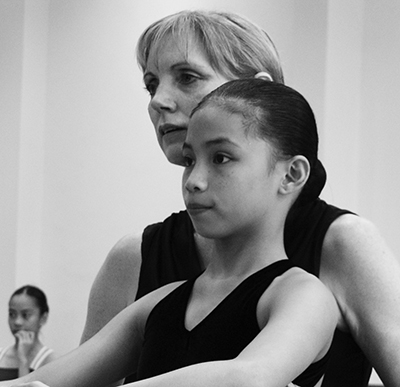Teresa Randall
Ballet Dancer & Teacher

Published, EAC Communiqué, August 1987
o have to sit still and express myself in words? Teresa Randall is arrested in mid-movement at the horror. “I couldn’t express myself; take dance away and I would shrivel up and die.” The 29 year old, now living in Fergus, opened her dance school four and a half years ago and since that time the number of students has quadrupled. The 200 ballet, tap, and jazz students are enjoying the benefits of her training, experience, and philosophy on the place of dance in one’s life.
Teresa was born in Nottingham, England to a real “ballet mum” – that timeless breed that knows no extinction – who sat up until 3 a.m. sewing costumes, crossed continents for competitions, and dug up tuition when the father was out of work. “I don’t know how they did it!” However, their dedication and her love of dance made Teresa different from her peers in the end of town where “dads went to the pub after work and mums tidied the house.”
Although it has taken her time and distance to appreciate her own parents’ sacrifices, she now sees, and is grateful to, the ballet “mums and dads (who) enrich the entire school, always available – just pick up the phone.”
Teresa’s original goal was to become a “good company dancer,” and she would likely be there today were it not for the onset of puberty. “I’ve these shoulders and not those sleek little thighs – you could take all the skin off me and I still wouldn’t be under 100 pounds.” Although she was congratulated on her dancing, she was counselled to teach. Her initial disappointment has given way to feeling that this alternative, this life, is one of challenge, action and growth. Teresa also feels that in becoming a teacher she is honouring those special people she admired as a student and now, to see the transformation dance effects on certain students, “that’s
something special”.
Teaching children is definitely a challenge. “There are things those little bodies are not capable of doing.” And as she carefully pushes towards those limits, she also tries to stay tuned to the differences and sensitivities of the children. “They all learn differently. The visual, audio and kinaesthetic learners.” Ballet is the root discipline of all other dance; the fine motor skills, the control – it has to be there for the jazz and tap classes. For many of Teresa’s students, ballet and the accompanying classical music are acquired tastes and most are more comfortable “wriggling” to jazz and tap.
She considers dancers finely trained athletes – “If only the boys realized that.” Teresa regrettably has no male students. Some have started and thoroughly enjoyed it only to be “discouraged” by their peers. And she says sarcastically, “A true hockey dad wouldn’t let his boy go dancing!” It’s a lot to ask from a youngster, to be both athletic and artistic.
Her other frustrations come from residing in such a small community. There is always a lack of adequate space to dance as studios are usually rented by the square foot and the rent alone for dancers becomes exorbitant. Only a lottery win would build her dream performing arts centre. The other “small town” frustration is overcoming prejudice. “One is in a small town because one happens to live there, not because one is no good.” Even some examiners have been caught blurting out, “I was really surprised at how good….”. So good in fact that four of Teresa’s students were chosen to perform in the Pittsburgh Ballet’s “Nutcracker” at Centre In The Square.
A few years ago Teresa started exercise classes for some interested “ballet mums”. The watered down jazz classes are supplemented with knowledge gained from anatomy classes taken during her own training. She is typically saucy and deprecating when teaching an exercise class: “What good is the icing on the cake –” indicating the pretty face- “if the cake is no good” – a baleful gaze at the length of the body. And in further analysis, “The body doesn’t want to do things you want it to do!” Body mechanics, counting, phrasing, obscure and reluctant muscles -a lot to think about. But the will over the obdurate body, the trials of performing, the development of self-confidence and self-knowledge – it is a unique discipline, this mastery of dance
or exercise.
Teresa’s immediate family, husband Frank and daughters Cassandra and Nadia, also augment her dance work. Both children are dancers and Frank runs the business side of things. “If I was the type of person to know where the dollars are coming from and going to, I wouldn’t be a dancer. It’s the old right brain, left brain bit.”
Having been here just short of five years “settling in”, Teresa expects to be here for some time yet. And all the while pushing herself and her students, “Keep at it, keep working at it. If they’re willing to put in time, work, and every ounce of energy they’ve got – they’ll get there!”.
And there’s Teresa Randall teaching – dancing, talking, pointing, explaining… “Well, why is the pas de basque like this? Because it comes from a folk dance and they tried to make it a little more elegant by turning the leg out like so…..”
by Sandra Cairns, August 1987
“A true hockey dad wouldn’t let his boy go dancing!” It’s a lot to ask from a youngster, to be both athletic and artistic.”
UPDATE – 1997
In October 1996, Teresa Randall was one of two Canadians taking part in a two week tour of China with an international delegation of dance. She was chosen by the Royal Academy of Dancing. The tour group surveyed and discussed Chinese and Western traditions of classical dance and teaching methods.
UPDATE – 2005
Teresa Randall has studied dance pedagogy in China, Russia and London, England, where she qualified as a ballet examiner for the Royal Academy, only one of eight in Canada.
Teresa Randall ran her own ballet studio for 15 years. Her experience in teaching adults and children has led her to Canada’s prestigious National Ballet School, teaching in both the Junior Associates and Teacher Training Programs.

